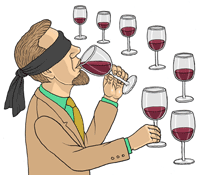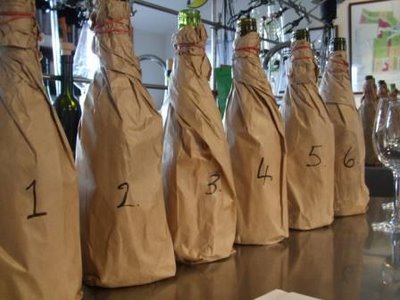This evening I participated in a FUN double blind wine tasting with members of my wine tasting club. Not to be confused with a triple blind tasting…

…where one does not know anything about the wine they are tasting and they are not even allowed to see the wine.
A double blind is when you CAN look at the wine but you are not told anything else about the wine.
Our group organizer (and frequent host) put together a list of acceptable varietals/regions and set the minimum price at $20. I suppose since we were working off a list of about 20 -30 varietals & regions that it was not a true double blind, but I tell you what – we sure were laughing at ourselves and having fun.
Anyway, each of 10 of us in attendance brought a wine that fit the list criteria, and brought it in a brown paper bag with a plain brown/tan rubber band.

We then numbered the bags and began the tasting with #1.
What added to the fun (besides the no pretension/expectation environment) was that we decided to score our tasting guesses (1 point each; per varietal, country & region) and tally total points. We each also kicked in $7, and the person with the most points won a bottle of wine.
So how did I do you ask? Let’s just say I could have traded in my “Wine Tasting Guy” moniker for “Wine clueless Guy”.
Of the 10 wines I successfully guessed two. But one of the two was the wine I brought (A Sonoma Syrah) (2 points), so I really only deserve credit for guessing 1 of 9, an Argentinian Malbec (2 points – but I was unsure and thought it might end up being a Chilean Cab).
Of the other 8 wines I scored ZERO on four of them. I thought a Washington Cab was a Grenache from Priorat, Spain (it seemed light to me). I guessed a (stinky) NY Cab Franc was a Spanish Rioja. I guessed a Gigondas was an Italian Piedmont Nebiollo. And I guessed an Italian Tuscan Sangiovese was a Burgundy. ZERO POINTS FOR ME.
Of the remaining four I guessed that an Oregon Pinot was a New Zealand Pinot (1 point), That an Italian Barbera d’alba was an Italian Sangiovese (1 point), that another Oregon Pinot was a Sonoma, CA Pinot (2 points – 1 for country and 1 for varietal). And that an Italian Chianti was an Italian Dolcetto (1 point).
So for those of you counting at home I scored 9 points. Two other guys scored 9 points…but someone scored 12, another 13, and the winner scored 14.
I was content with how I did, but (happily) realized I have a long wine journey ahead. And a fun journey it will be.
Happy BLIND wine tasting!!!
WTG
Tags: blind tasting, double blind, triple blind
Warning: Declaration of Social_Walker_Comment::start_lvl(&$output, $depth, $args) should be compatible with Walker_Comment::start_lvl(&$output, $depth = 0, $args = Array) in /home/u640618151/domains/winetastingguy.com/public_html/wp-content/plugins/social/lib/social/walker/comment.php on line 18
Warning: Declaration of Social_Walker_Comment::end_lvl(&$output, $depth, $args) should be compatible with Walker_Comment::end_lvl(&$output, $depth = 0, $args = Array) in /home/u640618151/domains/winetastingguy.com/public_html/wp-content/plugins/social/lib/social/walker/comment.php on line 42
hahahaha! Been there, done that! Nothing more humbling than to have your great palate humbled by wine. You did great. In my case, I chose the wines and had tasted them. How many did I figure out correctly? ONE! Out of six. Oh well. That’s what’s called “learning.” Love the post!
Oh G, sorry dude. I usually kick ass blind picking March Madness brackets over the guys. Too much knowledge can hurt!
Wow, you did a great job as I can’t even differentiate all differences and complexities of French wines! I know only French and Argentinean wines and I wish I could differentiate a Saint Julien from a Haut Medoc or a Pomerol.
[…] has created focused wine tasting sessions. Last month we did our first of what I hope is many double blind wine tastings. If you haven’t read about it you should. But things got serious a few months ago when we […]
That’s an interesting article. I just wondered if you could tell me where to find more info on this topic ?
Great blog. Can’t wait to see what you come up with next!
Single and double blind are technical terms from science. Single blind is where the host knows which wine is which, probably from putting the bottles into bags, such as in the “Pepsi Challenge.” If your host pours you a wine without telling you that it is, that is single blind. Single blind experiments can be influenced by experimenter bias. In other words, the host may consciously or subconsciously communicate to his own preferences or bias. To rectify that there are double blind experiments where nobody participating knows which is which. In a clinical drug trial the doctor does not know if the pill he is giving you is the real drug or a placebo. In wine tasting, everyone may know what wines are among the group being tasted but nobody knows which is which, including the host.
In the double blind tastings I attend, the host decants the wines into eight identical bottles numbered 1-8 and writes down which wine is in which numbered bottle. He leaves the room and someone else comes in, places labels with the letters A-H over the numbers, and writes down which number corresponds to which letter. Now nobody knows which wine is which and the tasting is “double blind.”
Any way you do it, a blind tasting is superior to tasting while a winery rep tells you how it tastes.
This is a very interesting article. The highest score out of a possible 30 was 14. I was always convinced these people who could smell, then take a sip and slowly twirl it around in their mouths and tell you which wine it was, where it came from and if the vineyard faced north or south, were con men. I’m convinced much of the wine expert thing is so much twaddle. I remember hearing years ago of a scandal where expensive French wine had been blended with cheap plonk and sold as the real stuff. None of the wine connoisseurs were any the wiser. It got out when someone involved had a fall-out with the others in the scam.